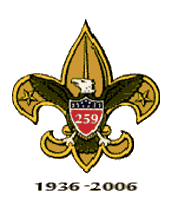|
|
|
|
|
"Under his patronage and guidance, American Boy Scouting as we know it today received its impetus. From that original vision of Mr. Boyce, have developed the thousands of troops of clear-eyed healthy young men, representing all that is finest in American youth..". -- Eulogy by James E. West, Chief Scout Executive of the BSA Born: June 16, 1858 Plum Township, Allegheny County, PA Died: June 11, 1929 Ottawa, Illinois Memorial: Plum, Pa. William D. Boyce used his childhood experiences and his success as an international publisher and businessman to create the Boy Scouts of America (BSA). Investing his time and personal fortune, he laid the foundation of what was to become the first national organization to enhance the belief that the youth of today can create a better tomorrow. Since its founding in 1910, more than 110 million young people have participated in and benefited from Boy Scout activities. Today, there are more than 3.3 million American Boy Scouts. Thousands of men and women serve in positions of leadership and instill the principles of leadership, morality, and good citizenship into the members. It is laudable that nearly 70 percent of Air Force, Naval and US Military Academy graduates have been Boy Scouts, as have 72 percent of US Rhodes Scholars and 26 of the first 29 astronauts. Born of "sturdy pioneer stock" in 1858, William Dickson Boyce's parents raised their family of three on a hillside farm in what is now Plum, Pennsylvania. While little is known about his childhood, one thing is certain: from the beginning, Boyce was a "go-getter", working hard and working close to the environment. It was here that Boyce first fell in love with all that the great outdoors offered: the isolation, the rural life, the self-reliant satisfaction of working with your hands and seeing immediate results. This early-life experience had a profound effect on him, ingraining in him a background that he would later return to in both business and pleasure. After attending the Wooster (OH) Academy in 1878, he went to Chicago. An imposing figure with a quick mind and an extroverted personality, people were drawn to Boyce. He rapidly formed the reputation of being a persuasive salesman. In his business as well as in his personal life, Boyce wasn't satisfied with staying in one place. The books he would write had a common phrase: "We pushed on." He hopped from city to city, exploring and soaking up everything there was to learn. All this would be fodder for great stories to fill those books. Boyce traveled extensively. In Winnepeg, Canada he co-founded a newspaper about the Northwest Frontier that would publish for the next 70 years. He worked as a reporter in Fargo, North Dakota. In December 1882, in Lisbon, North Dakota, he started the Dakota Clipper, a weekly newspaper specializing in political and business intrigues. Boyce simultaneously published the paper while organizing and managing the New Orleans Cotton Exposition. Readers were soon aware that they shouldn't feel tied down to one location; there was a whole world out there just waiting to be explored! In 1883, he married Mary Jane Deacon, whom he knew from his hometown in Pennsylvania. She gained the nickname "Rattlesnake Jane" by matching his skill in poker and being an expert shot. In January 1885, Boyce sold his newspaper, returned to Chicago and set up a syndication service for small town papers. He quickly launched even more newspaper businesses: the Saturday Blade, the Chicago Ledger, the Chicago World, and Farming Business, all with a combined circulation of 500,000 copies per week by 1894. Boyce was the first person to see the value of using newspaper boys to sell his papers, and he was careful to look after their welfare. As many as 30,000 boy-agents helped sell his weeklies and they were partly responsible for his huge business success. Working with these young men gave him an understanding of the needs of America's youth. Faced with the threat of increased second class mail rates, Boyce attempted to privatize the U.S. postal system in 1906. He believed that all newspapers and periodicals should be delivered free of postage and he designed a plan to purchase the Postal Commission for $300 million and run it under government regulation. Although his efforts failed, in making the offer, Boyce is said to have halted a planned rate hike. Boyce was a multi-millionaire by the early 1900s and he traveled the world extensively, often as part of hunting expeditions. But, he became increasingly disenchanted with financial success. By age 51, he grew less interested in making money and more interested in developing a civic role, in making a difference. And he found that role from his childhood experiences -- scouting, traveling, and writing. On one of his hunting expeditions in British East Africa, Boyce came across the Baden-Powell Boy Scout organization of England. As legend has it, he was lost in a fog in London when a boy came to his aid. After guiding him to his destination, the boy refused a tip, explaining that, as a Scout, he would not take a tip for doing a good turn. This gesture inspired a meeting between Boyce and Lord Robert Baden-Powell, the head of the Boy Scout movement in England. Boyce would later refer to that influential boy as the "Unknown Scout". Four months later, on February 8, 1910, Boyce founded the Boy Scout movement in the United States. The organization was officially chartered by Congress in 1916. Boyce based the new Boy Scout movement on Indian lore and centered it's activities around the characteristics of the English Boy Scout organization. Boyce assumed the title "Chief Totem" and soon had an effective program of activities under way. This first Boy Scout venture failed because of poor organization. However, with help from YMCA executives Edgar Robinson, J.A. Van Dis, and Dr. L.L. Doggett, all of whom had a deep interest in establishing the Scout movement, he redoubled his efforts to establish the Boy Scout movement on a firm management footing. When two similar, but separate groups, the "Woodcraft Indians" and the "Sons of Daniel Boone" were brought into the Boy Scouts, Boyce suddenly had professional skills at his disposal, skills that he desperately needed. However, there was little or no money available from donations to continue the organization. In response to this crisis, Boyce personally provided the financial backing to keep the organization alive for the next year. He contributed at least $1,000 per month to the Boy Scouts, a handsome sum for the times. His generosity came with one condition: that the Boy Scouts include all boys, regardless of race or creed. Boyce clashed with James West, who had assumed the duties of executive head of BSA, and Boyce's name was virtually erased from BSA records and publications for years. In 1915, Boyce undertook a new scouting related venture. Discovering that Boy Scouting was unavailable to country, farm, and small town boys, Boyce organized the Lone Scouts of America (LSA). The LSA appealed particularly to the geographically isolated boy, and LSA opened up the joys of scouting to everyone. The organization grew with extraordinary speed and a half million boys became Lone Scouts between 1915 and 1924. By 1924, Boyce's annual contribution to the LSA had grown to over $100,000. This outlay became so much of a personal financial drain that the decision to merge the LSA into the BSA was made. When his only son died of an embolism, Boyce apparently lost the will to live. He died shortly thereafter in Chicago on June 11, 1929. He is buried in Ottawa, Illinois. Today, William D. Boyce's birthplace in Allegheny County Pennsylvania is commemorated by Boyce Park and Boyce Campus, both featuring extensive outdoor activities.

Troop 259
|
|||||


 Troop 259
|